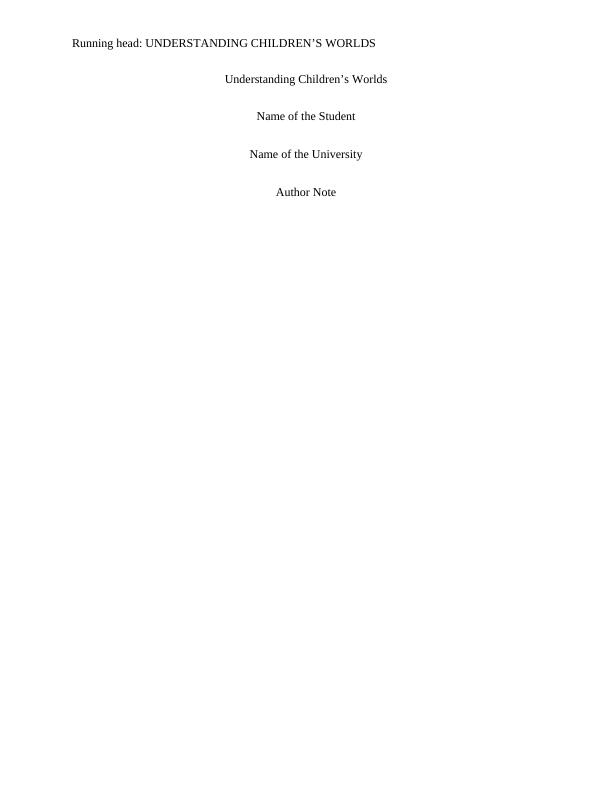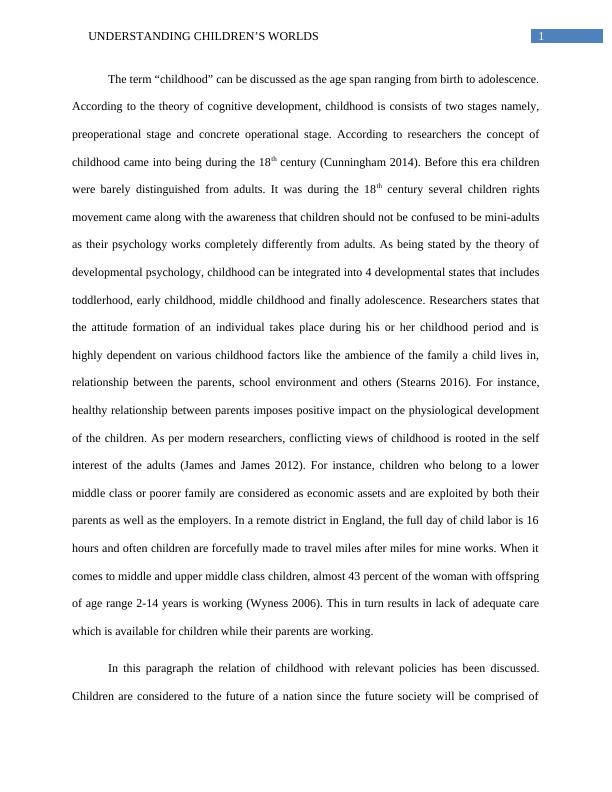Understanding Children’s Worlds: Historical Development, Contemporary Discourses, and Impact on Society
Added on 2023-06-10
9 Pages2686 Words203 Views
Running head: UNDERSTANDING CHILDREN’S WORLDS
Understanding Children’s Worlds
Name of the Student
Name of the University
Author Note
Understanding Children’s Worlds
Name of the Student
Name of the University
Author Note

1UNDERSTANDING CHILDREN’S WORLDS
The term “childhood” can be discussed as the age span ranging from birth to adolescence.
According to the theory of cognitive development, childhood is consists of two stages namely,
preoperational stage and concrete operational stage. According to researchers the concept of
childhood came into being during the 18th century (Cunningham 2014). Before this era children
were barely distinguished from adults. It was during the 18th century several children rights
movement came along with the awareness that children should not be confused to be mini-adults
as their psychology works completely differently from adults. As being stated by the theory of
developmental psychology, childhood can be integrated into 4 developmental states that includes
toddlerhood, early childhood, middle childhood and finally adolescence. Researchers states that
the attitude formation of an individual takes place during his or her childhood period and is
highly dependent on various childhood factors like the ambience of the family a child lives in,
relationship between the parents, school environment and others (Stearns 2016). For instance,
healthy relationship between parents imposes positive impact on the physiological development
of the children. As per modern researchers, conflicting views of childhood is rooted in the self
interest of the adults (James and James 2012). For instance, children who belong to a lower
middle class or poorer family are considered as economic assets and are exploited by both their
parents as well as the employers. In a remote district in England, the full day of child labor is 16
hours and often children are forcefully made to travel miles after miles for mine works. When it
comes to middle and upper middle class children, almost 43 percent of the woman with offspring
of age range 2-14 years is working (Wyness 2006). This in turn results in lack of adequate care
which is available for children while their parents are working.
In this paragraph the relation of childhood with relevant policies has been discussed.
Children are considered to the future of a nation since the future society will be comprised of
The term “childhood” can be discussed as the age span ranging from birth to adolescence.
According to the theory of cognitive development, childhood is consists of two stages namely,
preoperational stage and concrete operational stage. According to researchers the concept of
childhood came into being during the 18th century (Cunningham 2014). Before this era children
were barely distinguished from adults. It was during the 18th century several children rights
movement came along with the awareness that children should not be confused to be mini-adults
as their psychology works completely differently from adults. As being stated by the theory of
developmental psychology, childhood can be integrated into 4 developmental states that includes
toddlerhood, early childhood, middle childhood and finally adolescence. Researchers states that
the attitude formation of an individual takes place during his or her childhood period and is
highly dependent on various childhood factors like the ambience of the family a child lives in,
relationship between the parents, school environment and others (Stearns 2016). For instance,
healthy relationship between parents imposes positive impact on the physiological development
of the children. As per modern researchers, conflicting views of childhood is rooted in the self
interest of the adults (James and James 2012). For instance, children who belong to a lower
middle class or poorer family are considered as economic assets and are exploited by both their
parents as well as the employers. In a remote district in England, the full day of child labor is 16
hours and often children are forcefully made to travel miles after miles for mine works. When it
comes to middle and upper middle class children, almost 43 percent of the woman with offspring
of age range 2-14 years is working (Wyness 2006). This in turn results in lack of adequate care
which is available for children while their parents are working.
In this paragraph the relation of childhood with relevant policies has been discussed.
Children are considered to the future of a nation since the future society will be comprised of

2UNDERSTANDING CHILDREN’S WORLDS
adults who are currently at their childhood stage. Hence the fact that government posses a huge
responsibility to ensure a safe and secure childhood that will help parents to rise responsible and
mature adult, can’t be ignore. In UK, several policies to support a healthy childhood are their
under the Childcare and parenting policy (Wells 2009). Under the policy, pregnancy and birth,
both maternity as well as paternity pay and leaves are provided to the parents so that they can
spend a good amount of time with the child. Along with that in order to ensure that children are
not adopted for unjustfull purpose, the fostering, adoption and surrogacy policy has been
implemented. In order to ensure that children with both parents working are able to obtain
effective care, financial help is provided to the parents for employing baby sitters (Wild and
Street 2013). In order to ensure effective education, free early childhood education to poor
children is provided.
In this paragraph, description and evaluation of historical development of the concept of
childhood in Western Europe has been performed. The history of childhood has been a subject
of interest in social history since the highly significant book Centuries of Childhood, published
by French historian Philippe Ariès in 1960. According to him, before the 17th Century, children
were considered as mini-adults. When it comes to history of childhood in Western Europe, it can
be divided into the Preindustrial and medieval era, early modern period, the enlightenment era
and the modern childhood. During the preindustrial era, the upper middle class as well as elite
families generally involved grandparents, patents, children as well as relatives. However, the
typical pattern of middle class Western Europe families involved parents and children. Children
were often sent off to relatives as servants in case they needed help. In this era, marriage at a
very tender age was a social norm in Europe. Until the 19th century, education in the sense of
training was the function of families for the majority of children. Thus, it can be evaluated that
adults who are currently at their childhood stage. Hence the fact that government posses a huge
responsibility to ensure a safe and secure childhood that will help parents to rise responsible and
mature adult, can’t be ignore. In UK, several policies to support a healthy childhood are their
under the Childcare and parenting policy (Wells 2009). Under the policy, pregnancy and birth,
both maternity as well as paternity pay and leaves are provided to the parents so that they can
spend a good amount of time with the child. Along with that in order to ensure that children are
not adopted for unjustfull purpose, the fostering, adoption and surrogacy policy has been
implemented. In order to ensure that children with both parents working are able to obtain
effective care, financial help is provided to the parents for employing baby sitters (Wild and
Street 2013). In order to ensure effective education, free early childhood education to poor
children is provided.
In this paragraph, description and evaluation of historical development of the concept of
childhood in Western Europe has been performed. The history of childhood has been a subject
of interest in social history since the highly significant book Centuries of Childhood, published
by French historian Philippe Ariès in 1960. According to him, before the 17th Century, children
were considered as mini-adults. When it comes to history of childhood in Western Europe, it can
be divided into the Preindustrial and medieval era, early modern period, the enlightenment era
and the modern childhood. During the preindustrial era, the upper middle class as well as elite
families generally involved grandparents, patents, children as well as relatives. However, the
typical pattern of middle class Western Europe families involved parents and children. Children
were often sent off to relatives as servants in case they needed help. In this era, marriage at a
very tender age was a social norm in Europe. Until the 19th century, education in the sense of
training was the function of families for the majority of children. Thus, it can be evaluated that

End of preview
Want to access all the pages? Upload your documents or become a member.
Related Documents
Developmental Psychology Studies Humans Acrosslg...
|9
|2867
|15
GROWTH AND DEVELOPMENT OF EARLY CHILDHOOD.lg...
|10
|2843
|1
Common Theoretical Perspectives on Child Development and Learninglg...
|6
|630
|85
Reconceptualising Children, Childhood, and Identitylg...
|14
|3689
|485
Human Development Across the Lifespanlg...
|8
|2053
|361
Psychosocial Theory and Ecological Systems Theory in Child Developmentlg...
|9
|1904
|283